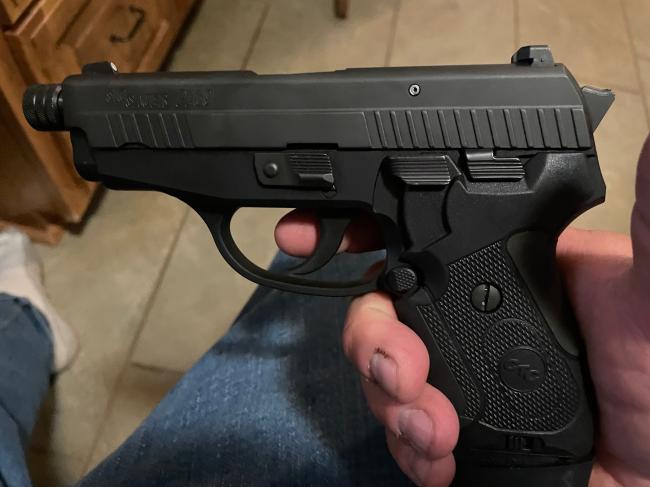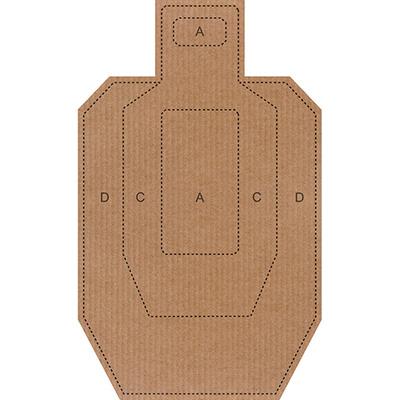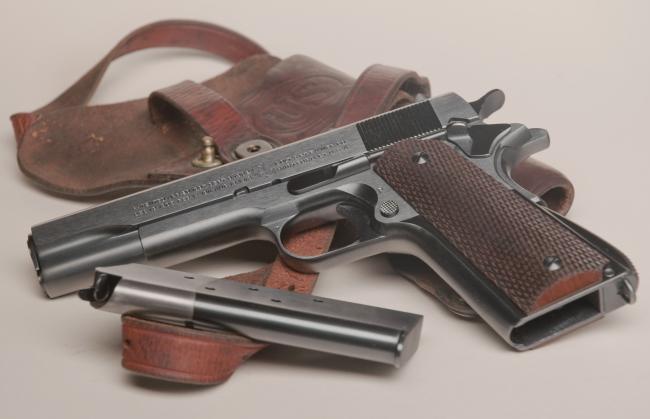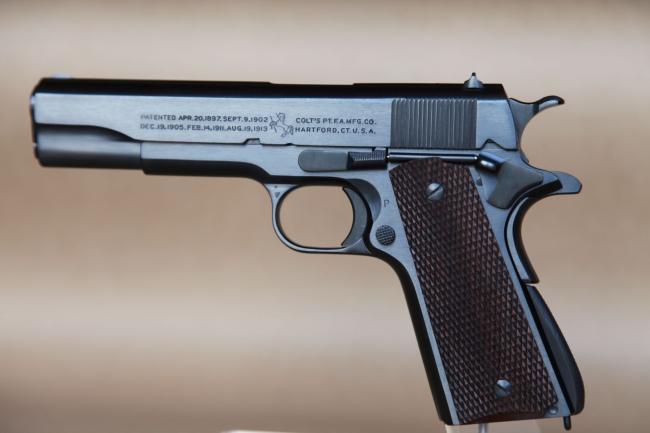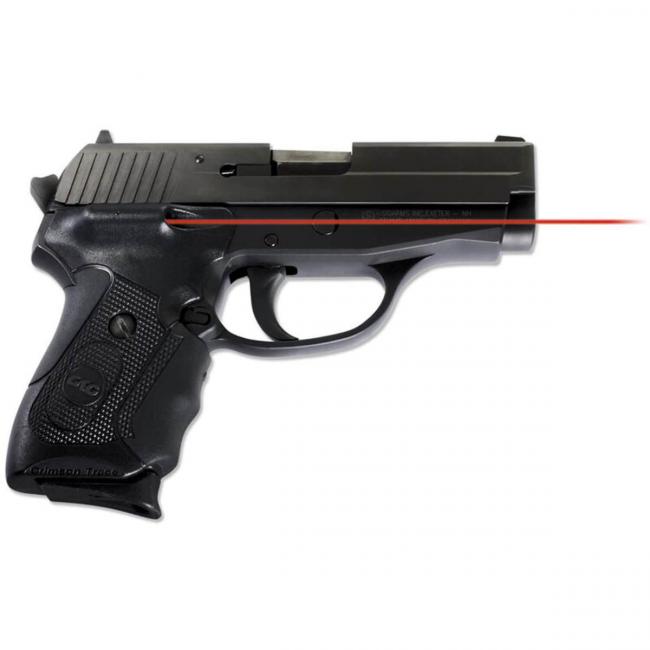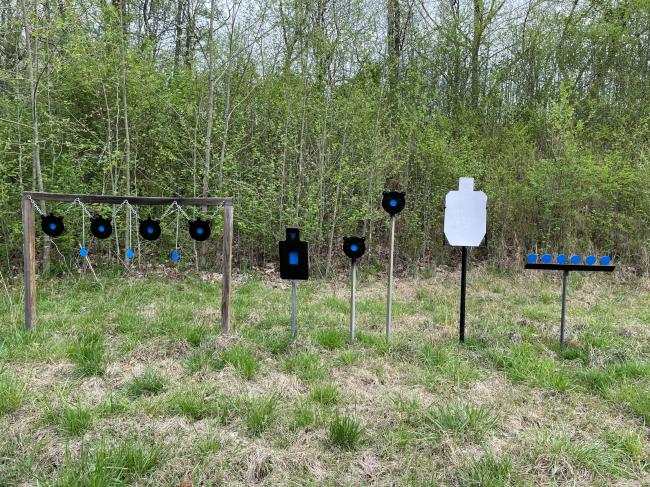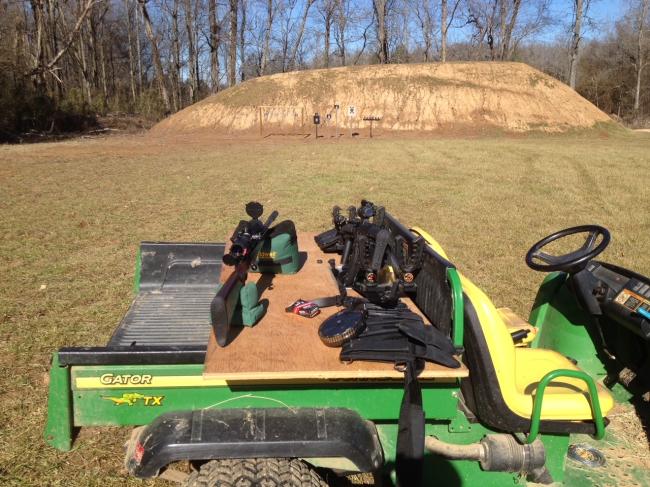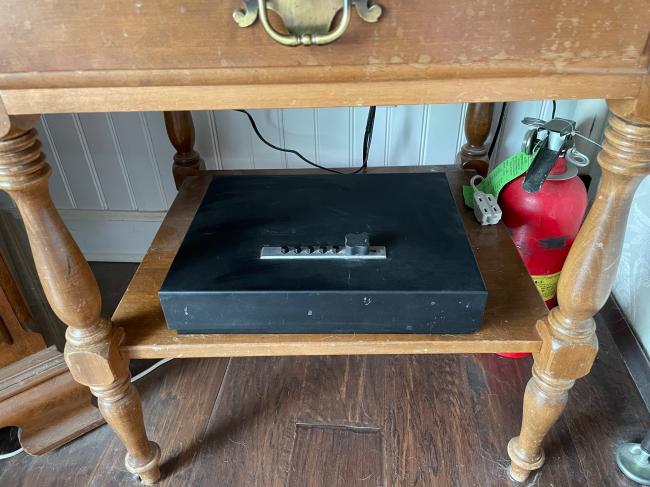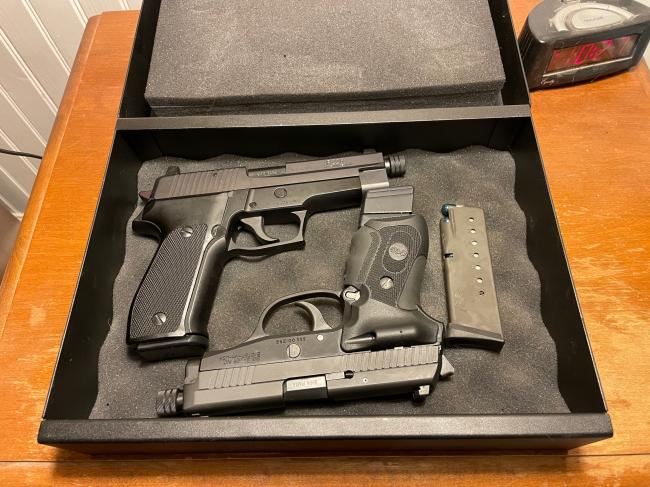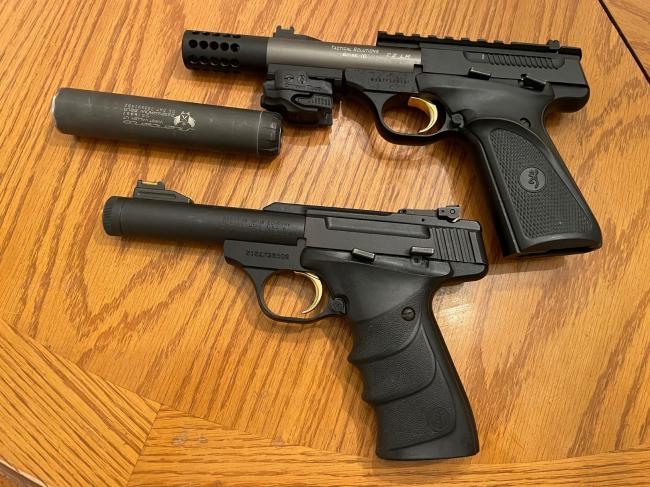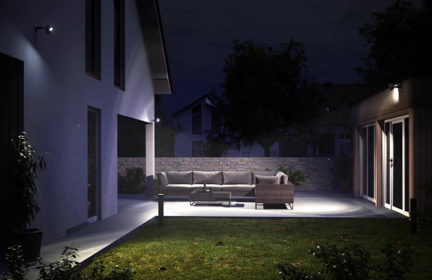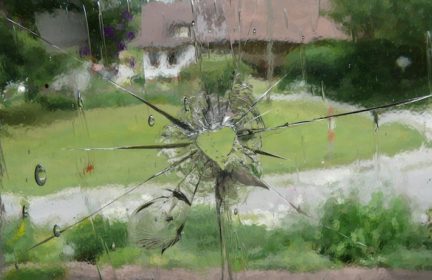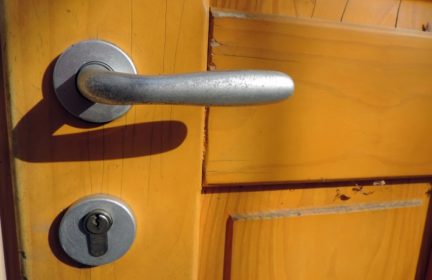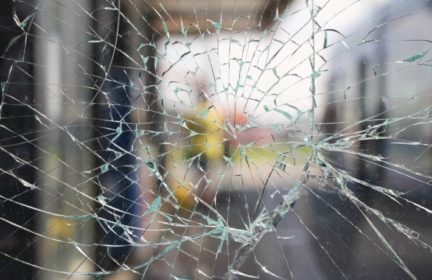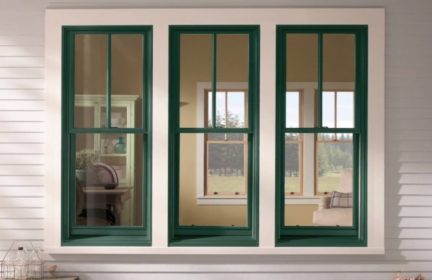Home Invasion – Preparation that could have prevented or changed the outcome
Re first post: https://theprepared.com/forum/thread/home-invasion
Let’s look now at what could have been done to prevent or change the outcome of this scene.
The home did not have a security system to alert that four men had approached the property and split into two groups, each heading for an exterior door.
Security cameras wrapped around the house, set with perimeter alarms, infrared and enabled with facial recognition would have alerted the wife who was in the kitchen and possibly the sleeping husband.
She then could have pressed a 911 panic button while simultaneously alerting her husband. He would have been on his feet with a side arm drawn. His wife would have her side arm drawn and ready to defend instead of leaving it upstairs in her purse.
The husband would not have weak core muscles. The family would be healthy, fit and ready to defend with good cardiovascular conditioning.
The front and back doors and their respective door jambs were easily breached. It isn’t difficult to use a pry bar on a wooden door jamb, bypass poor door locks and make entrance through a wood door. Window inserts and sidelight panels that are installed into doors make it that much easier.
Steel door jambs bolted properly into the house with solid steel doors secured by properly fitted and installed dead bolt locks would have been a major deterrent.
Four unmasked men entering your home when it is obvious that the inhabitants of the home are present is a huge red flag that you have now entered a life and death experience.
Thieves usually go out of their way to avoid the inhabitants of a place that they rob. A home invasion may have robbery as part of the motive, but it also implies violence.
The German Shepherd is a protective breed, however, no dog is ever immune to harm. A dog can be a wonderful companion animal or early warning alarm. Any breed can try to defend their human pack, but they are too easily killed. Don’t rely on it as a source of protection.
The husband can hear commotion in the kitchen while he is being overcome. He should know by now that there have been multiple breaches and his wife is also in trouble.
He also knows that there are no guns used to control him, only a knife, gag and zip ties.
As his wife is dragged past him, he notes that she is injured, but lucid and restrained in the same way.
There is only one man watching the two of them. Immediately, he and his wife enact their prepared home invasion response.
She distracts the male guarding them with a fit of coughing while he removes a bobby pin from the waistband of his pants. He removes the coated tip from the bobby pin and wedges it between the interlocking teeth and ratchet of the zip tie.
He learned this technique and others by reading Clint Emerson’s books “100 Deadly Skills” and “100 Deadly Skills The Survival Edition.”
Because they have prepared, his wife can reasonably anticipate what her husband will do and jumps up to further distract the man who is watching them. This allows her husband time to respond and disable the intruder from behind and neutralize him.
There are three men upstairs who are able to attack the unsuspecting children because both children used noise cancelling headphones. Anything that disables part of your senses creates an opportunity for an intruder or assailant to attack you. If worn, headphones need to allow for hearing.
In a prepared family, the children would not be wearing headphones, they would have both heard their mother yelling “Dave,” their family code word for intruder in the house, get out now, no questions asked, leave your BOB, get to the neighbors and call for help. They would have had a chance to open their bedroom windows selected for a rapid open and egress design and exit the upstairs via their individual fire escape ladders.
The children would have known to escape at the first sound of trouble even without the family code word for an intruder because they were prepared.
The wallet and purse were easy to find and should have been put away out of sight. It could have bought them more time to react.
In the scenario, the unprepared husband and wife know their children have been harmed because of the commotion upstairs. The children are not with the three men who come downstairs.
The husband was given a pen to write down his info. His hands were zip tied in front of him. He could have used a ploy of saying something in a very low tone to encourage the man closest to him to bend lower. They were gagged so it would involve removing the gag to understand him.
Once the man was positioned, the husband had the option of stabbing him in the throat at the soft part above the v notch that marks the windpipe or in the eye with the pen. A swift upper cut to the jaw with his elbow or double palm strike upwards below the nose would neutralize that one long enough to go for the next man.
Zip tied arms in front of him could become a weapon simply by capturing the next man over the head from behind. A choke would take too long, but rapidly sawing back and forth, with a focus on the carotid artery would ensure a five minute departure for the second man as he bled out.
Once his wife saw him attacking the second man and using him as a barrier against the third man, she could go after the fourth man.
When he moved to restrain her, she jumped on his feet and threw her body weight against him, knocking him on the ground. Once down, she reverted to a feral response and used her teeth as a weapon and tore into the soft tissue of his carotid artery in order to stop him. The fourth man must now keep pressure on his artery or he dies faster.
She runs to the fireplace and rubs the zip tie back and forth across the sharp stone in order to free her hands. Then she grabs a heavy dining room chair and bashes it over the head of the third man who is fighting with her husband. Together they overpower him and run out of the house to find their children at the pre-arranged safe houses with their neighbors.
In the distance, the sound of sirens draw closer.
A prepared family avoids trouble through good interior and exterior security enhancements. They have a code word and plan for trouble in the home. The know how to overcome restraints. They have weapons throughout the house that can be deployed if they are caught unawares. Their preparedness allows them to always work as a team. The children know what to do and do it according to the plan. They know that in a matter of life or death, feral action is warranted.
They knew to recognize the severity of unmasked intruders who entered their home while they were at home. The unmasked aren’t trying to hide their identity, which means they intend to kill you.
-
Comments (60)
-
Bob - April 11, 2021
Good morning Ubique,
It’s a timely thread with the key required feature being prevention / preventive measures. The above neighborhood watch thread is really a distilate of what Napoleon and Wellington’s brass and troops did: while some rested on lazy, comfortable Sunday afternoons, some continued working the multiple perimeters of security.
A tangent beneift of a neighborhood watch program is obtaining the economies of scale for individual members to learn and derive benefits from the group.
For country living, perimeter security by geese rather than our canine family members are more efficient and economical.
The Hampton Roads – Washington, D.C. corridor (“Navy Norfolk – D.C.”) is a tactical garrison area – with the waterways even more of a “garrison” than the land areas. … even better than the air space. During the Cold War, Areoflot flights enroute to Havana via Gander were frequently inside US airspace. Now, the entire corridor is security-conscious.
Some security matters have changed. Masked versus intruders no longer follow the original rule. Gas / smoke masks and hoods and laser protection googles / hoods distort the original rule.
I have a hunch some think neighborhood watch programs are Grandma Jones with binoculars working both neighborhood gossip and neighborhood observation/reporting. It’s been upgraded.
-
UbiqueContributor - April 12, 2021
Good Morning, Bob
Thank you for the link. Good info on that website. I have saved it.
Re Napoleon and Wellington – letting one’s guard down. Other battles have probably been lost for the same reason. One side took a break.
Neighborhood watch can offer learning as well as protection for the group. I wish more people would do it.
Yes, geese are excellent. We have people in this area who use peacocks and peahens. They make formidable watch birds. They have the most shrill and loud screech to alert for intruders. There was also a farm with osterichs. Not sure about that one. They have a kick but I don’t know what they would be like to work with. I think I would go with geese or peacocks. We had geese on the farm.
I didn’t know about the Hampton Roads area so I did a quick read on wiki. Amazing. There is a lot to absorb yet, but what struck me first was the geography and history of the area. I didn’t know that it is one of the world’s largest natural harbours. The garrison aspect is understandable. Also that 80% of the economy is federally based.
Good point about the masked intruders not following the original rule. I think it would be better to consider any intruder in one’s home is a lethal threat. Our laws here afford full force defense if faced with an intruder inside the home.
It is a shame that there a misconceptions about neighborhood watch and what this kind of organization can do.
I wrestled with even posting this scenario. I have limited experience and understanding of online social communication and convention. I wanted to introduce the idea of being fully prepared versus conditional prepping. Maybe it’s too much.
For me, it can’t be about conditional prepping i.e. prepping as long as it doesn’t get too ugly. In the real world you go feral in you want to live.
I wrote both threads to help others who have not been impacted by violence understand that you can and must go there in your mind if you want to survive in real life and that equates being prepared. You have to train for it.
-
-
Maarten V - April 12, 2021
Well written, Ubique!
I’d be surprised if you’re not already an established author of realistic thrillers.There’s a part of home defense training I’ve wondered about ever since I read an account on Reddit (unfortunately, I haven’t found it again).
It was from a woman who encountered the classic “you hear a noise downstairs at 4AM” and found some guys robbing her place.
She grabbed a knife and then… froze.
The robbers didn’t attack her, but didn’t run away either.
They just carried on, looting her place and ridiculing her.She didn’t know what to do.
She felt like she just couldn’t charge at these men and plant a knife into their bodies, potentially killing someone.
(that’s why several people on Reddit commented using blunt weapons for home defense instead of edged weapons)
So training is a big part of preparedness in such a situation, but how do you deal with those high-stress situations and the idea you may need to take someone’s life? Especially in such a visceral way as using a knife.
Especially if that someone is not (yet) an active threat to your person (like in that Reddit story).
The old “never brandish a weapon you don’t intend to use” applies here.
What if they had attacked her? Maybe that would’ve pushed her through her mental barrier, but maybe it wouldn’t have and they’d used the knife against her.
So my question is:
How do you know in advance whether you’re capable of using (potentially) lethal force and how do you train that “killer-instinct” properly?
-
UbiqueContributor - April 12, 2021
Hi Maarten V,
Thank you for the kind words.
To answer your question first,
“How do you know in advance whether you’re capable of using (potentially) lethal force and how do you train that “killer-instinct” properly?”
As far as knowing in advance what you are capable of, I can’t answer that for you. Only you will know the answer to that question.
To answer the second part of your question, to refer to what I am trained in as “killer-instinct” is a misnomer and lumps those of us who are peaceful warriors in with the bad guys.
I am peaceful, non-violent person. I don’t like violence because of what I have survived. I have dealt with violence and life threatening situations before and after I trained.
My training involved visualizing an opponent each time I threw a punch or kick or sparred. Some of the methods I learned are brutal, but again, they are not something I will ever use if I can escape instead.
If there is no doubt of the assailant’s intent and I am unable to escape, then I will deliver those methods because it is either going to be him or me. There is no emotion in it at that point, no anger, no fear, just pure survival. I know what I am capable of because I know myself that well.
I was also raised by a father who was a veteran with PTSD. My mother had it also. I was raised to think and understand the world in a particular way. I did not have a typical childhood.
I am not familiar with the Reddit story you have related. It sounds like the woman in the story who had the knife was experiencing the “flight-fight-freeze” response. I have included this link so you can read about it further if you would like:
https://en.wikipedia.org/wiki/Freezing_behavior
It is probably a good thing that she did not attempt to “attack” one of the intruders as “grabbing a knife” does not equal being able to defend successfully with one.
Knife combat is not simple. If you get cut, even a small nick, can produce blood which can render your grip very slippery. Stabbing at someone takes time and energy. A wound inflicted on a lethal point ends the fight quickly.
It is no different that a person who shoots well but can only hit non-lethal spots on their target.
I am a hand and foot fighter. I don’t like to rely on weapons. Anyone can become disarmed. It doesn’t mean I won’t use an improvised weapon if it is necessary to do so.
In your Reddit story, when she heard a noise, the first thing she should have done is call 911 as quietly as possible.
She should have escaped from the upstairs and that would have been possible with a proper fire escape ladder. This is something anyone who lives in a multi-storied home should have on each bedroom window. These are ladders that cannot be used to climb up, but are deployed in the event of an emergency.
Next is the issue of attacking an intruder or intruders. The last thing anyone should want to do is engage in physical combat.
In the movies, it all looks very easy and cool to watch. In reality, it is very difficult even if you are well conditioned.
Try punching a heavy bag about 200 – 250 lbs for as hard as you can for as long as you can as if you were in a real fight. Stop immediately if you experience any cardiac symptoms.
The heavy bag approximates what it is like to punch a person. It is why I was taught to target other areas. The longer you remain in a fight, the greater the risk that something can go wrong for you. Knowing where to strike, expedites matters.
Then if one factor stress into it for the average untrained person, it is easy to understand how difficult combat can become. Breathing is the first thing to go in a fight. People become oxygen depleted very rapidly. They literally forget to breathe.
I will exercise the full extent of my training to save my life or someone else’s life if there is no other recourse. The way I was trained is in the way of ancient tradition. Combat is the last resort.
In the scenario I wrote, preparation was the key to survival or a better chance of survival. Through preparation the family would be able to avoid a problem in the first place. I personally believe that combat training/martial arts training is very good for preppers to study and learn well. Tae Kwan Do or Grav Maga are two martial arts that can help, as can Aikido.
When we prepare, we avoid trouble and that was what I wanted to illustrate.
Thank you very much for your reply, Maarten V.
-
Maarten V - April 12, 2021
Thanks a lot for your thought-provoking response.
And yes, 100% agree with your stance on combat/martial arts training. My first weeks doing Krav Maga not only tested my body, but the “stress drills” were a true gauntlet for the mind as well.
-
UbiqueContributor - April 12, 2021
You are welcome, Maarten
It’s nice to hear from someone who understands the philosophy of of martial arts training.
Good for you for training Krav Maga! It is such a wonderful practical approach to training.
I have watched some of their training videos and long wanted to train in it, however the closest training facility to me is too far to train daily. Still, it would be nice to even do an intense weekend training seminar.
The “stress drills” are a gauntlet of the mind. It is amazing how our perception of what we can do or endure changes when we train.
Success or failure begins in our brain. An instructor taught me that our brain is our biggest weapon. It has proven to be good advice.
How do you find your Krav Maga training has made you more prepared for emergency situations or disasters? Example, I found I was better able to function under stress. Have you experienced that also?
-
Conrad B - April 12, 2021
Just watched The Karate Kid last night. Makes me want to learn some basic martial arts. bonasi!
-
UbiqueContributor - April 12, 2021
You would love it Conrad! Training in a good school can change your life.
You become self-assured, not arrogant, and it shows in how you walk and carry yourself. I can spot another martial artist every time. It’s like how dancers move. There is a difference in their bearing.
I met some wonderful people while training also.
Another bonus is that it truly helps you learn to cope better with stressful situations.
It’s important to select a good school with a good credentials and good club philosophy. There are some duds out there.
-
Maarten V - April 13, 2021
Good question!
Fortunately for me (but not for the hypothesis), I haven’t really encountered any critical moments to test whether my training made me handle emergency situations better.
There was a significant change in managing outbursts of anger, like road rage, however.
And it made me a lot more confident on the street and during social interactions.
So I imagine it would apply to stressful survival situations as well, definitely.
But now, mainly because of COVID lockdowns, I haven’t trained properly in over a year and it has definitely affected me negatively (both physically as mentally), so I can’t wait to start again.
-
UbiqueContributor - April 13, 2021
Hi Maarten,
Your ability to manager anger is a huge asset in the ability to manage a crisis.
Do you know that therapist have said that behind anger is fear? If we are stressed or fearful, which would be a reasonable emotion in a crisis, then the ability to reduce our reactions helps us to respond better to the situation at hand.
I found also that my training made me more patient with people.
I also learned to consider the intent of a person before I reacted. Did that person intend to anger or upset? Usually people don’t intend to be unkind. Sometimes they make mistakes. They are human.
Confidence is a wonderful quality to have and I am glad you found it too in your training 🙂
-
-
RedneckContributor - April 12, 2021
I don’t live in a war zone, so I don’t prepare anywhere near to that extent. My old neighbor, down the road at the end of or lane told me in all his years here, he only had one crime event… a family member stole something.
I think one factor in preventing such an attack is the same with all prepping… stealth. If you have money, don’t show it. I drive an old beat up pickup and dress like a common laborer. I dress that way as it is comfortable, I own my own business so no one to tell me what to wear, plus I do labor on my farm. My wife is ashamed to be around me when I dress like this.
I do have plenty of guns around the house, all locked properly. I almost never have one on me & don’t travel to work with one. I do keep 3 throwing knives & my survival knife wedged between the bucket seats & the center console for quick access. More importantly, I train on my home range for home defense shooting. All my shooting is in close… I’m no sniper. When I train with my suppressed 300 Blackout AR, I normally shoot at around 50 yards. I don’t train for extreme accuracy. I train to simply hit center mass with a double tap & do it quickly. With pistols, I get in close… maybe 5-10 feet. With this training, I don’t use my sights. I train to snap shoot, where soon as my arms come up, I fire. Once again, I train to simply hit center mass. Matter of fact, today after work, both of my adult sons are coming to the farm for some pistol training. Having guns are great but are of little value if one doesn’t train very, very often.
I have a home alarm but in all the years we have lived here, I’ve never turned it on. It is so safe here, I never lock the house when I go off for errands. I do lock it when I go all day to work. My rural alarm is my 9 dogs in the house with 24 hour access to our back yard. That plus, our neighbor’s big dog that stays out front. At least one dog barks whenever a car approaches our gate out front. If a car enters the gate, then several bark as it comes down our long drive. When anyone is outside the house, all 9 let go and boy do they make a racket. I have no expectation that these dogs would attack. Their job is simply to alert.
-
UbiqueContributor - April 12, 2021
Hi Redneck,
I do many of the same things that you do.My van is so old, the neighbors are embarrassed for me. I dress down also.
You understand the importance of ongoing training with your firearms. I like your point about not training for extreme accuracy. You are not trying to become a sniper, just to as you say “hit center mass with a double tap & do it quickly.”
You know the situation I have here, and there are changes which I have been monitoring. It is a wait and see right now. We have many hoops to jump, so I carry on without that option as back up for the moment.
It’s funny how perspective works. I lived on a farm with a very similar sensibility. No one locked their doors. One collie was enough to herd cattle and let out a few barks to announce that someone arrived.
When we moved to the city, I learned just how dangerous the world could be. Situations that weren’t supposed to be dangerous were very bad.
I am not a jaded person, but I am realistic. There are predators out there. There is crime and some of it is very bad.
We think it can never happen to us, and then one day it does. Your home is chosen and not someone else’s home. Your child is hurt and not someone else’s child.
The violent crime is the one I try to warn people about. It is the one most of us cannot conceive of experiencing, until it happens. Many survivors of violent crime will not talk of it and it is a shame because what we know can help others.
You have prepared in your way for how to handle security. Low key is a really good way to avoid the financially motivated thieves.
There are always the violent criminals and psychopaths to contend with. To them, it doesn’t matter what you look like or what you wear. They are predators and all they want is another victim.
Those are the ones I have run up against and they are the ones I defend against.
Thanks very much for replying, Redneck. Always appreciated.
-
RedneckContributor - April 12, 2021
As you state, some locations are more dangerous than others. For that reason, our actions need to fit the circumstances. In your case, you are basically in a war zone, so utmost precaution & actions are warranted. In a very rural setting like mine, less is needed.
I still will take a pack of dogs for alert any day over any electronic means. Electronic is probably cheaper but nothing gets by their senses.
I can’t stress enough the need for gun owners to practice with your guns. Folks have been know to do some stupid things when under stress, such as dropping the magazine when attempting to take off the safety. Constant training builds muscle memory so that stupid things are less likely. That is one reason my handguns are all Sig Sauer. They have no safety. In a stressful situation, that is one less possible fatal error to be made. No button needs to be pushed for the gun to go bang.
-
UbiqueContributor - April 12, 2021
Well said Redneck,
I use my dog’s instincts in addition to security cameras. I always watch how she reacts around people. That tells a lot.
I wish more people would listen to your points on gun safety. Guns gathering dust equal deteriorated skills. Also your point on building muscle memory is excellent. It keeps the hand/eye coordination sharp.
Very good point on the Sig Sauer.
Thank you Redneck
-
RedneckContributor - April 12, 2021
For me, the training & the muscle memory have less to do with hand eye coordination ( accuracy) than with familiarity with your gun in a stressful time. I could care less how accurate I am, as long as I can simply register hits. Many handguns have safeties and likewise have other buttons, say for magazine removal or hammer de-cocker. When stressed & unfamiliar with your firearm, confusion can reign… when last year at the range there was no confusion. The repeated training, at least for me, will reduce any confusion with the gun when stressed.
-
UbiqueContributor - April 12, 2021
To clarify, Redneck and anyone else reading this:
I support your point Redneck, under stress, it doesn’t have to be textbook hits.
I just happened to read an article on hand/eye coordination a couple of days ago relating to brain health. When I included that in my remark above it wasn’t referencing firearm accuracy.
As I was typing my reply, I was thinking back to that article and how building hand/eye coordination in any way helps our brains. It seemed to me that practising with a firearm using hand and eye would help our brains.
Apologies for the confusion.
It is a bonus to know that when you practice your shooting skills, you are helping your brain. So, there’s an incentive for anyone who has a firearm and isn’t practising with it. If you practice, your brain benefits 🙂
-
RedneckContributor - April 12, 2021
Great news! I need all the help I can get. 🙂
I had a good shooting this afternoon with my boys. They enjoyed it greatly and realize they need to practice more… especially since their dad whooped them bad. They especially liked my snap shooting technique. Every round was center mass without aiming. I highly recommend folks learn this style of shooting handguns.
Here is my Sig P239 that I shot today. It is my smaller 9mm Sig, that is single stacked which keeps the gun smaller, thinner & lighter. His big brother, my Sig P226 is considerably larger & heavier.
-
Robert LarsonContributor - April 12, 2021
I bet those were good memories. What’s the snap shooting technique like? Just a quick snap draw and shoot from a holster?
-
RedneckContributor - April 12, 2021
Yes… good memories.
For me, I don’t draw from a holster but have the gun down at waist height, in front with both hands on the gun & finger besides the trigger guard in my normal “tactical” position… where I would hold it if danger near. I don’t practice a holster draw because my guns are normally in my pistol safe on my bedside table, loaded magazine inserted but no round in the chamber. So if used in a crisis, I wouldn’t be using a holster. Only holster I typically use when armed while out about on the farmstead is a replica WWII tanker shoulder holster. I actually have an original one, with my father-in law’s Colt 1911 he wore in WWII & had with him as he crossed over at Normandy beach. That rig is very special to me. A museum piece that is never shot.
But the technique I use is to snap the gun up to shooting position & fire immediately without aiming. I just bring it up level & fire. So it is just up, point & shoot. Not the most accurate way of shooting but with practice I’m able to put all rounds on target. For this I use cardboard silhouette targets.
-
Robert LarsonContributor - April 12, 2021
That gun and holster sure would be a neat piece of personal history to your family. Did they give servicemen their guns to keep? I wonder if the current military lets soldiers keep their guns they served with as well.
-
UbiqueContributor - April 12, 2021
Robert,
Dad’s Enfield from WWII is in our family. I don’t know what happened to his service revolver.
It is a great keepsake and that rifle saw him through 7 years of service.
-
RedneckContributor - April 13, 2021
No, they generally didn’t want the returning soldiers to keep their pistols… but many did anyways as they could easily be hidden and so many soldiers were coming home at the same time. One of my employee’s grandfather told him as their troopship entered the harbor, there was a bin at the gangway. They were told to put their sidearms in there & that there would be all sorts of problems if they didn’t. Well he put his in and after passing that station, no one was ever searched. He was so mad that he didn’t keep his.
My late father-in-law kept his and later had it chromed. After he gave it to me, I did some research & it was an exceptionally rare model 1911 made in 1938, when very few were made. Left alone & in good shape, it would have been worth a fortune. In his honor, I had it restored back to its original condition. Here it is.
-
Bob - April 13, 2021
Beautiful, Redneck !
I carried one of the non-rare models in RVN.
Sand can be around the slide and it makes little difference. These things worked.
The pictured holster is also a beautiful piece of leather.
-
RedneckContributor - April 13, 2021
I carried a dinky .38 revolver when in the launch control center. 🙂 But I did qualify as expert.
What is amazing is both serial numbers match. That tells you it wasn’t a squad weapon. He was a supply sergeant and I guess that explains it. Amazing to think that holster & gun crossed over Normandy beach. My understanding is it was D+3. He was assigned to a P-51 unit and was part of a team that went over early to get an airfield in France ready.
-
UbiqueContributor - April 13, 2021
Oh Redneck, It is beautiful.
Well done for restoring it to it’s original condition.
It is indeed, museum quality.
You are very blessed to have it.
-
Caliber Carpenter - April 12, 2021
What redneck is referring to is called point shooting, in which you use your body’s natural ability to align itself in order to align your weapon with your target without having to aim down your sights. It’s a good technique for extreme close range shooting when speed and effective rounds on target are what matters. However like many defensive tools, it is situationally dependent. Close range with just you and an attacker? Great time for it. Possible collateral damage beyond or around the threat? Not so much
-
RedneckContributor - April 12, 2021
Thanks, and yes situation shooting. One has to be responsible for each & every round. But the way I see it, in my situation, the most likely scenario that I’d use my pistol is a home invasion… probably in the dark. This technique is for when in close to your attacker & both of you are startled. Speed & the ability to put a round on target is critical.
IMO, this point shooting is a very safe way to engage a threat. One can get tunnel vision when aiming a gun & not see the big picture… such as who else is around. With point shooting, the gun stays down, out of your line of sight so that you can survey the scene better & make better judgements. So in a threat situation, you can change shooting style depending on what you see.
-
Caliber Carpenter - April 12, 2021
You’re exactly right and the home invasion in the dark brings up another thing often overlooked; the importance of weapon lights and training to use them. You can’t shoot what you can’t see
-
UbiqueContributor - April 12, 2021
TITW – I’m mired in the stoneage with our gun laws and hoping for positive amendments. I still follow information prepping purposes. I want to learn and follow aspects of firearm info. My experience is growing up with hunting, firearms and target shooting with friends, before things changed here.
So, I have some questions about shooting an intruder in the dark.
If one uses as weapon light does that light you up as well? Would night vision goggles work?
https://www.flir.ca/discover/ots/what-is-an-infrared-illuminator/
-
Caliber Carpenter - April 13, 2021
If by light you up you mean does it expose your position? Yes, the intruder will be able to see where the light is coming from and therefore expose your position. However the advantages given by a weapon light far outweigh this drawback. Most handgun mounted weapon lights are anywhere from 250-1000 lumens, which is more than enough to create a blinding effect on a threat, especially lights with a more focused throw pattern. Most long gun mounted weapon lights are 500 lumens and up, with many of the newer lights offering well over 1,000 lumens. This amount of light is absolutely blinding, and can even power through weaker lights, such as your average handheld flashlight. So not only does the light give you a direct physical advantage, the importance of obtaining positive ID in a low light situation cannot be overlooked.
Night Vision is an entirely different ballgame and a very expensive one. It is not really recommended for home defense unless you live on a lot of rural acreage and would have time in the night to throw on kit and patrol the property. It’s not a grab and go type thing like a handgun or longgun with a weapon light is. Even a “budget” night vision setup will cost anywhere from 3-4k
-
UbiqueContributor - April 13, 2021
TITW – Thank you very much for the clear and helpful explanation. I agree the advantages far outweigh exposure. The weapon light would be a much more realistic option for me.
Night Vision, while intriguing for it’s tech aspect, isn’t appropriate for my current environment. If I do find an acreage, then I can look at this then.
I’m waiting for the new changes in our gun laws to become effective. They enacted a restriction causing people to surrender their firearms. Then they changed their mind and changed the ruling about a year after the firearms were surrendered.
With an FAC, I can have a .22 cal and hunting rifles which aren’t great for SHTF self-defense.
For other types of firearms, I need a special license and to prove that I am the member of a target shooting club. The closest one is a 3 hour round trip. It could be doable if I only need to go once or twice a month to retain my special license.
I could negotiate target shooting with a neighbor on their farm and keep my skills up, if I can find a gun I can buy.
The link is for a current list, and there is restriction on ammo, also.
It would be easier if they gave us a short list of what we are allowed to have.
You guys are really so lucky you can bear arms without jumping through these hoops.
-
RedneckContributor - April 13, 2021
I personally don’t put a light on any of my pistols. I do keep one on an AR. My reasoning is, these handguns are primarily for home defense. As such, I want them as light as possible with no attachments that can get snagged on clothing etc. Another factor is by using a light, you do expose your position. Yes, your light might blind that person but that doesn’t stop them from firing at you, now that you have broadcast where you are located. Also, what happens if there is more than one intruder, which is rather common. You blinded one, plus yourself to some extent, but now the other now knows where you are.
Lights do serve a purpose, especially if you are at an unfamiliar place, such as police searching a home or business. But IMO, in your own home, you have the advantage over intruders, so why give that up? You know the layout… they don’t. On that Sig P239 that I shot yesterday, it does have an integrated laser built into the grip that is activated as you tighten your grip. I prefer that over a light in my own home.
-
Robert LarsonContributor - April 12, 2021
Thanks for the explanation. I imagine you would use this technique more often than you would shooting someone/thing at 50 yards.
I’ll have to schedule a day at the range and practice.
-
Caliber Carpenter - April 12, 2021
You don’t even have to go to the range to practice. Dry firing in your house will help develop the skill and muscle memory needed. Pick something in your house like a light switch, a candle, etc, and practice presenting your weapon at the target from either low ready or a holster. Do this enough and you’ll eventually get to the point where your sights should naturally snap to alignment when you present your weapon. Establishing this muscle memory is what is necessary for fast and accurate shooting whether you point shoot or aim down sights. By practicing this technique around the house your body becomes familiar with how the weapon naturally points and it will become second nature to present your weapon on target the first time, every time.
-
RedneckContributor - April 13, 2021
Completely agree. You can’t believe how much dry firing I’ve done in my house… especially when learning this technique. I find a laser helps but it is not necessary. When you practice, snap the gun up & keep it there. Then look thru the sights & see where it is aimed. You will be surprised how accurate you can become. As This Is The Way says, it really becomes second nature and that is my whole point of home defense… it needs to be so that you don’t have to think. You just respond as trained.
Training is critical. Just having a gun around can be exceedingly dangerous. Know how to use it & practice all the time. At a range if you can or at a minimum, dry firing at your home. Took this pic on my range this am. The other, older pic shows the berm behind the targets.
-
RedneckContributor - April 13, 2021
One last comment regarding firearms for home invasion. We have these guns & we train to protect ourselves, our family & our possessions. Another integral aspect of this protection is to ensure an innocent person doesn’t find your weapon & harm themselves or others. You have to protect yourself from that event.
All my firearms are locked up. Two of my pistols stay locked in a pistol safe on my bedside table. I don’t attach the safe because I’m much less concerned with theft than I am of some visitor handling the guns. This type of pistol safe is good in that the buttons are programable by the user. Just pick a series of pushed buttons and the safe unlocks. I can feel the buttons in the dark & can open it with my eyes closed.
-
Paulino Martin - April 13, 2021
Thanks for bringing up the point of keeping guns away from visitors. There have been too many news stories of kids getting into daddy’s guns with their friends and there is an often fatal accident.
Please, if you have kids or may have kids visiting your house, take the precautions necessary to keep them safe.
-
UbiqueContributor - April 13, 2021
Really nice case. If I can have hand gun down the road, I will get one of these. Very practical.
-
UbiqueContributor - April 13, 2021
Redneck,
You are so lucky. I can remember when we would target shoot on weekends. It was a lot of fun. Now, we just get to point a stick and yell ‘bang-bang’.
Here’s our list of banned firearms:
-
RedneckContributor - April 13, 2021
OK, that sucks! Sometimes we Americans take so much for granted. I’ve had a gun almost my entire life, starting with bb & pellet rifles.
-
UbiqueContributor - April 13, 2021
Redneck, It surely does. This is my dilemma now. I don’t want to do anything illegal. That’s not the right way.
I grew up with guns, but now people here who are responsible are being penalized. None of this will stop the criminals with the guns. It’s a mess.
Now, I guess you understand why I’m just sitting here without a firearm. I suppose I could use a .22 cal, but in close quarters in town here, a hunting rifle is not the solution. I don’t want to hurt an innocent person in a fire fight.
I have no idea what to pick. The hoops we have to jump through is absurd. It’s like they wanted to create a deterrent for anyone to have a firearm.
Maybe I’ll just get fishing gear and really nasty hooks and if the SHTF, I’ll just cast my fishing line and hope I nail the intruder with a hook. Yeah, that’ll teach ’em…
-
RedneckContributor - April 13, 2021
I have two .22 cal Browning Buck Marks. I love shooting them. They would not be my first choice for a home defense handgun, however if that is all you have, it would be fine. I’m of the school of thought that accuracy trumps caliber. Most people are more accurate with a .22 because they know it won’t kick. A double tap of two .22 LR in the heart will stop anyone. I shoot much more .22 LR than all other calibers combined. This is also why my Sigs are 9mm. There are bigger calibers but I find the 9mm to have little kick & therefor I’m more accurate.
To illustrate my point, a few years back I was doing some target shooting in a friend’s pasture. I was shooting my Buck Mark. My friend’s dad shows up to join in the shooting. He is past law enforcement & pulled out some huge magnum gun. Very manly. Trouble is, he couldn’t even hit the danged target. He was flinching really bad because he knew it was gonna kick like a mule & be very loud. My Buck Mark rounds were all on target.
So if the government will allow a .22 handgun, then don’t let the diminutive caliber hold you back. Here are mine. Both can accept the suppressor. One is modified to have a rail on top for a small optic if wanted. It has a laser on the smaller bottom rail.
-
UbiqueContributor - April 14, 2021
Redneck,
I really like your .22 cal Brown Buck Marks and the optional optic fittings. I think the .22 cal is the best option for now. I am still verifying the handgun option but I don’t think it will be a problem.
Your points on the .22 cal make a lot of sense for me. I know what kick back is like and my shoulder doesn’t concern me as much as my wrist. It doesn’t always bother me, but I think one has to be realistic. I have arthritis. In an emergency I can block out the pain, but the kick back from a larger cal hand gun could still affect my accuracy and that isn’t good.
Also, there is a huge advantage for ongoing target practice. The local Legion has a target range in the basement of the building. I believe this is the allowable .cal for that practice range. Our local FAC training person uses this space for teaching. This will allow me to train on a regular basis and not have to make arrangements with someone for a safe place to practice. More practice equals better accuracy.
I did reading this morning on .22 cal and bookmarked an article on it regarding type of ammo used and efficacy of various types for self-defense
https://www.crossbreedholsters.com/blog/22s-for-self-defense/
From what I understood from the article, the ammo will also make a difference. I could keep the better ammo in reserve for self-defense and use the other for target practice.
-
Caliber Carpenter - April 14, 2021
There are still a few defensive rifles that are not yet banned in Canada if you are interested in getting one. They are far fewer and far more pricey than here in the states but they can still be found. I’ll get you a list if you’re interested.
-
UbiqueContributor - April 15, 2021
TITW
Yes, absolutely I am interested in a list of those rifles. It would help a lot.
Thank you
-
Caliber Carpenter - April 15, 2021
Off the top of my head I know the IWI Tavor and the Norinco Type 81 are still available. I’ll post up the others later, I’ve got a buddy who knows the Canadian gun laws a lot better than me.
-
UbiqueContributor - April 15, 2021
TITW
Awesome! Thank you!
I’m on the IWI Tavor and Norinco Type 81 info and will check back later on the rest.
Thank you again!
-
Paulino Martin - April 13, 2021
I second dry firing drills, be extra cautious to remove ammo completely from the room before doing so though. Double and triple check!
Do your dry fire drills after breakfast when you are awake and most alert for the day. You don’t need office tired brain to mess up and forget a step.
Practice good safety techniques and never point an even unloaded gun at someone.
Practice in a mirror or in front of a camera so you can see your posture and positioning and focus on precision and good form.
One last tip that I like to do is to audibly announce what I’m doing. That is another way to connect the action to the brain.
“I am removing the magazine full of ammunition”
“I am racking the slide and do not see any ammo inside”
“I am feeling inside the gun with my finger and do not feel anything”
“This gun is safe and clear”
-
RedneckContributor - April 13, 2021
You can’t be too safe. I just don’t talk to myself. 🙂
A word of warning. Many guns will fire with the magazine removed, if there is still a round in the chamber. That is why we rack the slide back to make sure the chamber is empty. I repeat this step at least twice in a row just to be certain. But even then, with the magazine removed and the chamber verified empty, I still consider that gun loaded. Never point any gun at anyone. Want to see this rule ignored. Go to a gun shop & watch how the employees & some patrons handle the guns as they are inspected. It has gotten so bad, I never go to gun shops anymore. I buy them online & have them shipped to friend that has his license.
-
UbiqueContributor - April 13, 2021
Good safety hints Redneck and thank you for mentioning about never pointing a gun at someone.
I was out target shooting with a couple of friends, one of whom collected guns. We were walking along in the bush, when I caught out of my peripheral vision that the other person had his gun up and was carrying it in a such way as to point at my head.
Let’s just say, I delivered a very colorful admonishment. Just stupid. The friendship ended that day.
-
Maarten V - April 14, 2021
Great advice!
I got a CO2 replica of my 1911 with blowback to train inside the house.
For many, it’s not worth the investment, but for me it adds several benefits:
- The blowback ensures proper grip when drawing and firing
- You can put up paper targets around the house and blast them with plastic BBs. It’s adequately accurate for up to at least 5 meters/yards to simulate bullet trajectory. Wear eye protection and make sure the house is empty, though.
Although I don’t shoot BBs inside the house anymore since you’ll still find the plastic rascals everywhere for months after.
-
UbiqueContributor - April 14, 2021
Maarten,
The CO2 replica is a great idea for training.
Shooting inside the house wouldn’t work for me, but I would be able to set up targets elsewhere.
The plastic BB’s you find after shooting in the house could be another way to neutralize an intruder as a slip and fall 🙂
We have some challenging restrictions here now with firearms.
Thank you for the great suggestion!
-
UbiqueContributor - April 13, 2021
Really good gun safety hints. Thank you Paulino.
-
UbiqueContributor - April 13, 2021
TITW – Thank you for the excellent hint. It makes total sense. I will remember to practise this way.
-
-
Bradical - April 12, 2021
Wish I would have logged in earlier and could have commented my thoughts on the scenario before the revelation of the answers. I need to be more active on this site!
A home invasion is something that really scares me because my home is supposed to be my fortress, my security, my peace and relaxation. If someone was to burst in and do all those horrible things you stated, I would forever be scarred.
On my prepping-to-do list, I have placed home security upgrades. Reading your posts makes me want to move it up the list a bit. I got interested after reading all of the home security articles here on the prepared and seeing how easy and cheap it was to greatly improve your home’s defenses.
I know I keep linking back to this tv series, but it seriously is good! One of the episodes of the tv series Surviving Disaster focuses on Home Invasions. It goes over two scenarios, the first is just a low life burglar break-in. The second is like the one you described by a team of well trained and planned out thugs who have been targeting you for weeks because you are the manager of a bank with access to lots of money.
Some things that I’ve learned from that show is how to escape from zip tie hand cuffs or duct tape, how to escape from the trunk of a car, how to asses the situation, and ways to protect yourself.
-
UbiqueContributor - April 12, 2021
Hi Bradical,
Good to see your response!
A violation of our home is not something most of us expect. We may think that the lawn mower could be stolen, or a break and enter where they take the tv and stereo, but thinking that someone could break in to hurt us where financial motivation is low or non-existent, is a tough one to wrap our heads around.
I’ve experienced the violent criminals in situations that were not supposed to be violent and I learned that you need to understand predator behavior in order to stay safe.
Think like a predator for a moment. What do predators do in the wild? They don’t chase the fastest antelope in the herd. They go after the very young, very old, injured and ill. They want the easy kill.
I am careful to never present myself or my home as a potential victim.
I enjoyed the Surviving Disaster series also. It had many practical tips.
Clint Emerson has some good books. His 100 Deadly Skills Survival Editions deals with home invasion and crime in the home. I find his advice very “doable” and practical.
I believe that we need to include how to avoid and defend against violent criminals and predators as part of our overall preparedness.
Good for you Bradical for taking the initiative to learn about something that many preppers overlook.
Thank you for replying.
-
-
underprepraccoon - April 14, 2021
I think some degree of observation would be important as well, if a group is able to watch you for a long enough time to know when you are taking naps after meals and everyone is occupied, they very likely had to be watching the house for a long period of time. Being aware of new vehicles and people in the neighborhood seem like critical points of interest, and maybe setting up some sort of counter to that like privacy walls or privacy film on widows so anyone with a pair of binoculars can’t just look in and watch your day to day habits.
I also think some sort of door barricade would be extremely helpful in regards to this, they have electric ones that you can pop up though your smart phone that can hold hundreds of pounds and are separate from door locks, physically barring the door from opening.
If the people breaking in were aggressively over prepared, they would have to either injure themselves or bring heavier equipment to break down the door, giving more time to react. If they really wanted in, they would go with a widow but would be limited on how many could come in at a time. At that point they would probably choose another house but with the context of being a banker or something with access to big money, I think being picked off while going to and from work instead of directly attacking a house hold would be another part of it.
-
UbiqueContributor - April 14, 2021
underprepraccoon,
Routine is one way that predators identify and monitor a target. I avoid routine.
Awareness of surroundings and environment is a good countermeasure.
I have one way privacy film that I sourced from a UK company on my windows. They have distributors in North America. It works very well to keep prying eyes out while retaining a window treatment look from the exterior.
https://www.contravision.com/privacy-window-film/
Do you have the link or company info for the electric one you referred to? I would be interested to see it.
Predators prefer a soft target and thieves will go for the easiest place to break into.
The scenario was written as a generic family, not a banker or someone with money because I wanted to illustrate preparedness against violent crime.
There are predators who commit violent crime for the sake of the violence. If they get a few dollars out of the event, that is secondary to them.
I think crisis or situation due to violence is a tough one for most preppers to look at closely, because it is uncomfortable to consider. We have to consider it in order to establish good security practices in and around our home and while away from home.
I appreciate your thoughtful reply, thank you.
-
underprepraccoon - April 14, 2021
I can attest to that, a property of mine that isn’t used all that often was recently broken into and lived in by some people that were likely feeling the crunch of the everything. `There’s a lot of traffic around houses that don’t look lived in. It was definitely an expereience that’s made me rethink a lot of house security.
That’s some nice looking films, privacy coupled with the UV/infrared blocking to keep temperatures down in the summer is really helpful.
For TLDR they use the Haven lock connect https://havenlock.com/products/haven-connect-1
-
UbiqueContributor - April 14, 2021
underprepraccoon,
Security issues are the challenge of a seasonal or infrequently used property. We get cottages broken into here.
Lights on timers can help, set somewhat randomly. A couple of pairs of large muddy work boots at the front or back door can give the illusion of someone inside. Random noise, tv, music rotating throughout the day can also make it appear that someone is home.
Some of the security cameras have a mic where it is possible to address whoever is at the door. Mine have audio but not the outgoing mic. It is something I plan to add. I’m not certain, but I believe it works remotely as well. This way you could make it sound like you are at home, when you are actually away.
Thanks very much for the links on privacy films.
-
-
- News for the Week 2025-3-31 - 5 hours ago
- News for the Week 2025-3-24 - 1 week ago
- News for the Week 2025-3-17 - 2 weeks ago
- News for the Week 2025-3-10 - 3 weeks ago
- News for the Week 2025-3-3 - 4 weeks ago
This forum is heavily moderated to keep things valuable to as many people as possible. Full community policies are here. The basics:
- 1. Be nice to each other.
- 2. Stay focused on prepping.
- 3. Avoid politics, religion, and other arguments.
- 4. No unfounded conspiracies, fake news, etc.
- 5. Debate ideas, not people.
